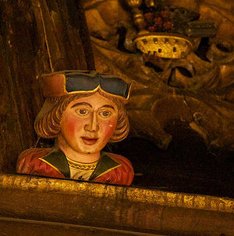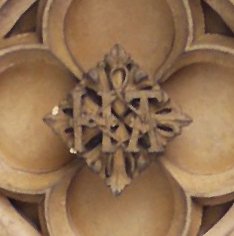See No Evil, Hear No Evil, Speak No Evil
Eavesdroppers at Hampton Court Palace
Henry VIII had a famously acquisitive nature – and it wasn’t limited to women. The man also had a passion for real estate. As king, he inherited many castles and palaces owned by the crown, but throughout his reign, he added others by purchase, trade, or payment of a debt; through reclamation to the crown due to attainder; “recovering” property through the dissolution of assets formerly owned by the Roman Catholic church; and by “gift.” A primary advisor in the early years of Henry’s sovereignty was Cardinal Thomas Wolsey, a man with tastes as extravagant as the King’s and who also had the means to indulge them. When the King saw Hampton Court Palace, Cardinal Wolsey’s sumptuous, Thames-side property, he envied him it. Knowing that he was on uncertain terms with the king, Wolsey offered Hampton Court Palace to him. Henry accepted the generous gift but did not reinstate Wolsey in his favor.
Once he owned the palace, Henry set about remodeling. One of the most beautiful reconstructions was the Great Hall. The Great Hall was a large chamber where the king dined in public and where entertainments were often held. Like everything else in Henry’s court, the hall was to be well-appointed to represent his power and glory. Historian Neville Williams claimed that masons worked round the clock for five years to complete the rebuilding of the hall to Henry’s showy satisfaction. The room would have been overpowering to the senses, the tastes and smells of rich foods and spices, the feel of lush wood paneling and tightly woven tapestries, the music of players, the courtly flirtations.
Delicate embellishments had been carved into the ceiling beams, among them an HA crest for Henry and Anne Boleyn, which can be seen today in the Anne Boleyn Gateway. Anne’s Coat of Arms can still be seen on the inner roof of the Great Hall; in fact, forty-three falcon badges remain, painted over in black after her downfall. The entwined HA initials can still be seen on the wooden screen in the Great Gall. But one of the Great Hall’s most interesting features lurked high above the heads of the guests, tucked into the dark corners of the roof beams.
The eavesdroppers.
The word eavesdropper has been in circulation since at least the 900s, coming from the old English yfesdrype. It meant then just what it means now - someone listening to conversations in secret, watching and hearing without the permission or knowledge of the speakers. The cherubic courtier faces would have smiled down upon guests, reminding all that Henry was aware of everything at his court through courtiers and servants. Even while at play, there was never a time for loose tongues among long ears, as those who spoke freely often did to perilous consequences. At the Tudor Court, it was better to see nothing, hear nothing, and say nothing till you were in private chambers where eavesdroppers, one hoped, did not lurk.
Eavesdropper photo copyright Helen Newall, http://tinyurl.com/hcpeavesdroppers
Entwined HA on HCP ceiling photo copyright Felicity Boardman

